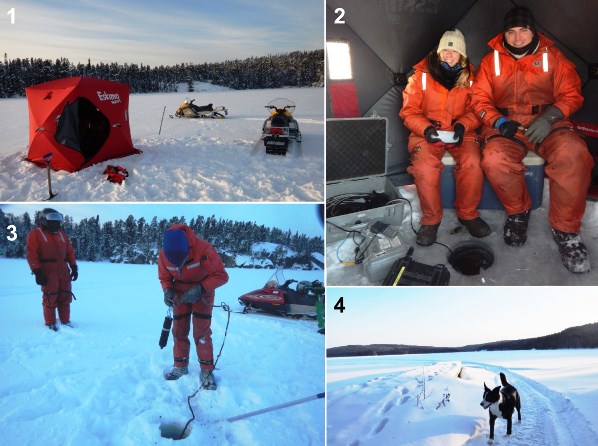It’s -40°C with the wind chill, snow is swirling outside the window, and it’s still dark. I roll over to check the time, hoping for a few more minutes cocooned in my sleeping bag. I’m at IISD Experimental Lakes Area for the first winter survey of the season with five of my colleagues, an assortment of chemists and biologists who are ready to brave one of the coldest weeks of the season. Our goal is to collect water samples and data for a number of the long-term and experimental lakes at IISD-ELA. After breakfast, we head over to the lab to get our equipment and personal gear. Winter sampling at IISD-ELA is a delicate balance of keeping warm, not getting too warm, keeping samples unfrozen, coaxing mechanical and scientific equipment to life, and making sure you have enough snacks to fuel your research.
On this trip, one of our main tasks involved collecting water samples and temperature data for six IISD-ELA lakes. Like in the summer, sampling took place on each lake at the “centre buoy,” which marks the deepest spot. Before sampling, we set up a pop-up tent that protected us from the wind, helped keep the sampling equipment running and kept the water samples in their liquid form (see photo 1). For each lake, we measured ice thickness and snow depth, water temperature and oxygen concentrations, and collected water samples from various depths. Photo 2 shows IISD-ELA biologists Chandra (left) and Colin (right) getting ready to fill bottles of water at Lake 373, a Long Term Ecological Research Lake. We kept all samples and battery-operated equipment from freezing by insulating them in coolers with hot water bottles, a crucial step in successful winter sampling. When we arrived back at camp, we handed the samples off to chemists, Roger and Sonya. After filtering the water, they worked long hours in the lab at IISD-ELA to conduct chemical analyses for the most time-sensitive parameters, including pH, dissolved nitrogen and dissolved phosphorus. Other analyses, such as dissolved organic carbon and chlorophyll, will be completed in the coming months in Winnipeg.
The other goal of our trip was to download data from the fish-tracking receivers (part of the ongoing Water Diversion study). These receivers hang from floats, which froze into the ice in the fall. At each float, I drilled a hole in the ice, used a long pole with a hook on it to fish out the receiver and downloaded the receiver data onto a laptop computer that I kept warm in a cooler. After the download, I put the receiver back into the lake to continue collecting data. We have been using these receivers to track depths of tagged fish 24 hours a day for more than 10 years! Photo 3 shows me clipping a receiver back onto its rope before lowering it into the lake.
Overall we had a very successful winter field trip. We sampled six lakes, analyzed many chemistry samples and downloaded all of the fish tracking receivers. Not bad for a week of work in the cold! We will do a second winter survey in early March to see how things are progressing. In the meantime, we will leave it up to camp managers John and Gerald, and camp dog Chance (photo 4), to keep things running smoothly at IISD-ELA!
